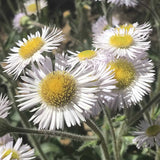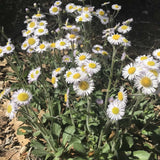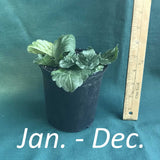Robin's plantain is a native ground cover with fuzzy, grey-green leaves and pale lavender daisy-like flowers.
- Evergreen
- Ground hugging habit
- Drought tolerant when grown in afternoon shade
Details
- Ground hugging foliage, with 12 in. tall flower spikes, spreading to 48 in. wide
- Plants spread slowly to form a dense groundcover
- Lynnhaven Carpet was selected for its attractive large leaves
- Hardy in USDA hardiness zones 5, 6, 7, and 8
Flowering period
Flowering begins in April in central North Carolina and lasts two to three weeks.
How to grow
Robin’s plantain prefers well-drained soil and full sun to partial shade. Plants will tolerate drought if they are grown in afternoon shade.
Care and maintenance
Very easy to grow and care for. Spent flowering stems can be left in place or cut back for a more tidy look.
Where to plant
Robin’s Plantain looks excellent planted at the edge of woodland beds or paths where it will form a valuable and attractive groundcover.
When to plant
Robin’s Plantain is quick to establish and can be planted any time the ground is not frozen.
Spacing
If planting in a group, space plants two to three feet apart.
When will my plant flower?
Plants should flower in the spring if planted before April. Plants purchased after April will flower the following spring.
Native habitat and range
Erigeron pulchellus grows in a wide variety of partially shaded habitats throughout most of the eastern United States.
Source and origin
Our plants are propagated by division. The original ‘Lynnhaven Carpet’ plant was discovered near the Lynnhaven river in Virginia.
| States | Orders up to $50 | Orders $51 to $100 | Orders over $100 |
| AL, DE, GA, KY, MD, NC, OH, PA, SC, TN, VA, and WV | $16 | $18 | $20 |
| AR, CT, FL, IL, IN, LA, MA, MI, MO, MS, NH, NJ, NY, RI, VT, and WI | $18 | $20 | $22 |
| IA, KS, ME, MN, OK, and TX | $20 | $22 | $24 |
| CO, NE, ND, and SD | $22 | $24 | $26 |
Sorry, we can't ship plants outside of the continental United States or to AK, AZ, CA, HI, ID, NM, NV, OR, UT, and WA due to agriculture restrictions.
When will my order be shipped?All plants are shipped within two weeks of placing an order.
Is it okay to plant in the winter?Yes, as long as the soil is not frozen. Planting native perennials in winter and early spring gives your plants a head start before the summer heat arrives.
What if it’s too cold to plant where I live, but I want to buy a plant before it sells out?Dormant plants can safely be kept in a basement, garage, or cool room until you are ready to plant in late winter or early spring.
How will my plants get delivered?Most orders are shipped on Monday or Tuesday via UPS Ground, which depending on the destination takes between 1 to 4 days.
Are your plants shipped in their containers?Yes, all our plants are shipped in their growing containers. The majority are grown in containers that are 4.5 inches wide by 5 inches deep and 32 fl. oz. / 946 ml in volume.
Do you guarantee your plants?We guarantee our plants to be healthy, ready for planting and correctly named. We are not able to guarantee whether a plant will grow in your garden as there are too many circumstances that are beyond our control.
On rare occasions, a plant shipped dormant may fail to emerge from its dormancy. If this happens, please let us know. If you are concerned about a plant, please contact us within 14 days to let us know. If we can’t help you make it grow, we’ll send you a new plant or issue a refund.
You can return your plants if you no longer want them once they arrive. To receive a refund (minus 20% restocking fee) the plants must be returned in good condition. Return shipping is the customer’s responsibility.
Can I cancel my order?Yes, you can cancel your order. Please visit our terms and service page for details.
What about sales tax?We propagate our own plants and are not required to collect North Carolina sales tax.
Where can I find information about your plants?Here are some FAQ on how we grow plants.









